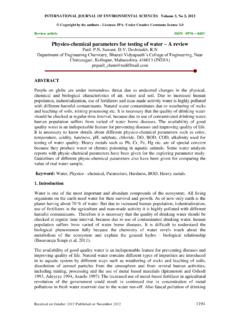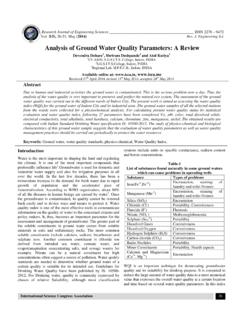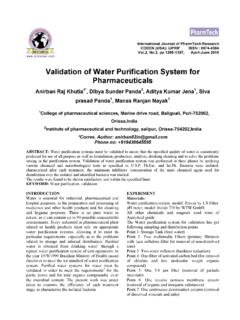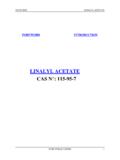Transcription of DRAFT OECD GUIDELINE FOR THE TESTING OF …
1 DRAFT Consultant Proposal v. 6 OECD TG 451 November 2008 1 DRAFT OECD GUIDELINE FOR THE TESTING OF CHEMICALS Test GUIDELINE 451: Carcinogenicity Studies INTRODUCTION 1. OECD guidelines for the TESTING of Chemicals are periodically reviewed in the light of scientific progress, changing assessment practices and animal welfare considerations. The original Test GUIDELINE 451 on Carcinogenicity Studies was adopted in 1981. Development of a revised TG 451 was considered necessary, in order to reflect recent developments in the field of animal welfare and regulatory requirements (1)(2)(3)(4)(5). The updating of TG 451 has been carried out in parallel with revisions of the Test guidelines 452, Chronic Toxicity Studies, and 453, Combined Chronic Toxicity\Carcinogenicity Studies, and with the objective of obtaining additional information from the animals used in the study and providing further detail on dose selection.
2 2. The majority of carcinogenicity studies are carried out in rodent species, and this Test GUIDELINE is intended therefore to apply primarily to studies carried out in these species. Should such studies be required in non-rodent species, the principles and procedures outlined may also be applied, with appropriate modifications, as outlined in an OECD Guidance Document on the design and conduct of chronic toxicity and carcinogenicity studies (6). 3. The three main routes of administration used in carcinogenicity studies are oral, dermal and inhalation. The choice of the route of administration depends on the physical and chemical characteristics of the test substance and the predominant route of exposure of humans.
3 Additional information on choice of route of exposure is provided in an OECD Guidance Document on the design and conduct of chronic toxicity and carcinogenicity studies (6). 4. This GUIDELINE focuses on exposure via the oral route, the route most commonly used in carcinogenicity studies. While carcinogenicity studies involving exposure via the dermal or inhalation routes may also be necessary for human heath risk assessment and/or may be required under certain regulatory regimes, both routes of exposure involve considerable technical complexity. Such studies will need to be designed on a case-by-case basis, although the GUIDELINE outlined here for the assessment and evaluation of carcinogenicity by oral administration could form the basis of a protocol for inhalation and/or dermal studies, with respect to recommendations for treatment periods, clinical and pathology parameters, etc.
4 OECD Guidance is available on the administration of test substances by the inhalation (6)(7) and dermal routes (6). The updated guidelines TG 412, Subacute inhalation toxicity: 28 day study (8) and TG 413, Subchronic Inhalation Toxicity: 90-Day Study (9), together with the associated OECD Guidance Document on acute inhalation toxicity TESTING (7), should be specifically consulted in the design of longer term studies involving exposure via the inhalation route. 5. The objectives of carcinogenicity studies covered by this test GUIDELINE include: the identification of the carcinogenic properties of a chemical , resulting in an increased incidence of neoplasms compared with concurrent control groups, the identification of target organ(s) of carcinogenicity, characterisation of the tumour dose.
5 Response relationship, identification of a no-observed-adverse-effect level (NOAEL) or point of departure for establishment of a Benchmark Dose (BMD), extrapolation of carcinogenic effects to low dose human exposure levels, provision of data to test hypotheses regarding mode of action (2)(6)(10)(11)(12)(13). DRAFT Consultant Proposal v. 6 OECD TG 451 November 2008 2 INITIAL CONSIDERATIONS 6. In the assessment and evaluation of the potential carcinogenicity of a chemical , all available information on the test substance should be considered by the TESTING laboratory prior to conducting the study, in order to focus the design of the study to more efficiently test for carcinogenic potential and to minimize animal usage.
6 Information that will assist in the study design includes the identity, chemical structure, and physico- chemical properties of the test articlesubstance; any information on the mode of action; results of any in vitro or in vivo toxicity tests including genotoxicity tests; anticipated use(s) and potential for human exposure; available (Q)SAR data, mutagenicity/genotoxicity, carcinogenicity and other toxicological data on structurally-related substances; available toxicokinetic data (single dose and also repeat dose kinetics where available) and data derived from other repeated exposure studies.
7 Assessment of carcinogenicity should be carried out after initial information on toxicity has been obtained from repeated dose 28-day and/or 90-day toxicity tests; short-term cancer initiation-promotion tests could also provide useful information. A phased TESTING approach to carcinogenicity TESTING should be considered as part of the overall assessment of the potential adverse health effects of a particular chemical (14)(15)(16)(17). 7. In conducting a carcinogenicity study, the guiding principles and considerations outlined in the OECD Guidance Document on the recognition, assessment, and use of clinical signs as humane endpoints for experimental animals used in safety evaluation (18), in particular paragraph 62 thereof, should always be followed.
8 8. Detailed guidance on and discussion of the principles of dose selection for chronic toxicity and carcinogenicity studies can be found in an OECD Guidance Document on the design and conduct of chronic toxicity and carcinogenicity studies (6) as well as two International Life Sciences Institute publications (19)(20). The core dose selection strategy is dependent on the primary objective or objectives of the study (paragraph 5). In selecting appropriate dose levels, a balance has to be achieved between hazard screening on the one hand and characterisation of low-dose responses and their relevance on the other.
9 9. Consideration should be given to carrying out a combined chronic toxicity and carcinogenicity study (TG 453), rather than separate execution of a chronic toxicity study (TG 452) and carcinogenicity study (TG 451). Careful consideration should however be given to the principles of dose selection (paragraphs 8 and 19-23) when undertaking a combined chronic toxicity and carcinogenicity study (TG 453), and it is also recognised that separate studies may be required under certain regulatory frameworks. 10. Definitions used are given in the Annex. PRINCIPLE OF THE TEST 11. The test substance is administered daily in graduated doses to several groups of test animals for the majority of their life span, normally by the oral route.
10 TESTING by the inhalation or dermal route may also be appropriate (paragraphs 3 - 4). The animals are observed closely for signs of toxicity and for the development of neoplastic lesions. Animals which die or are killed during the test are necropsied and, at the conclusion of the test, surviving animals are also killed and necropsied. DRAFT Consultant Proposal v. 6 OECD TG 451 November 2008 3 DESCRIPTION OF METHOD Selection of animal species 12. This GUIDELINE primarily covers assessment and evaluation of carcinogenicity in rodents (paragraph 2). The use of non-rodent species may be considered when available data suggest that they are more relevant for the prediction of health effects in humans.
















